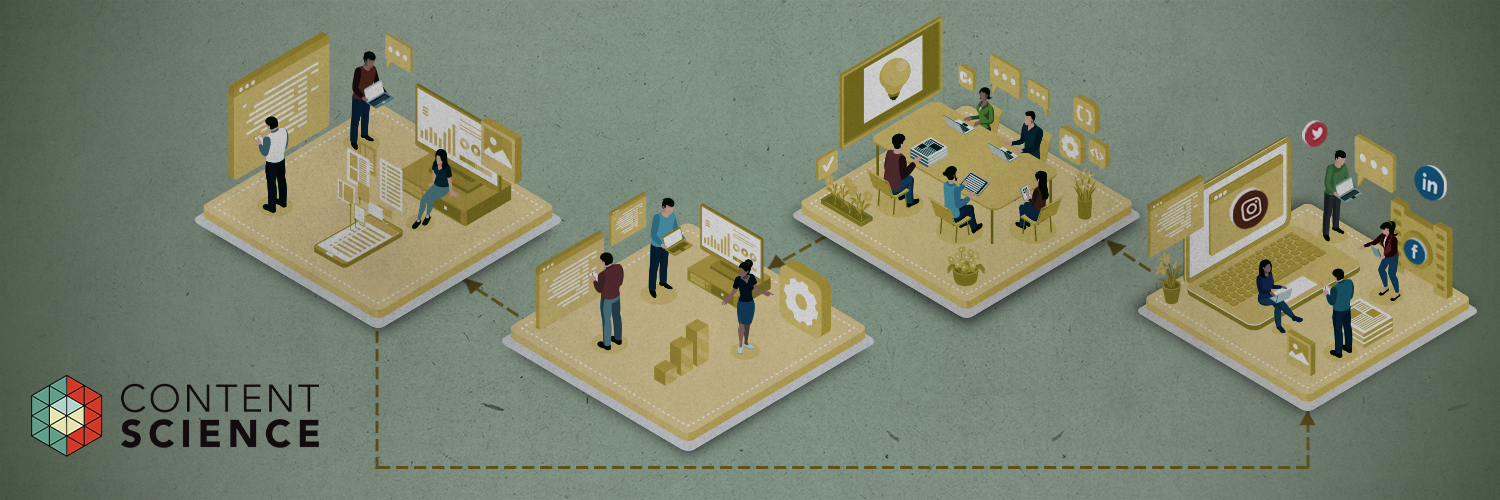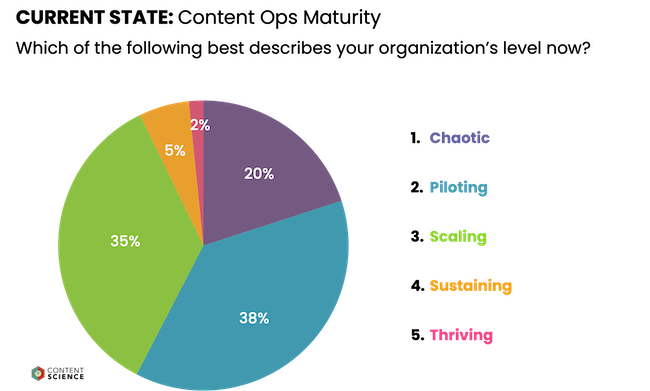
You have a content vision and content strategy. You know what kind of effective and influential content you want to offer. You’re committed to establishing a system of content intelligence to inform ongoing content decisions. Now, you need to execute. Unfortunately, there is no content fairy ready to wave a magic wand. But there is a growing discipline that I call content operations, and it will help you sustain and even scale your implementation.
Definition of Content Operations
At Content Science, we define content operations like this:
Content operations is the behind-the-scenes work of managing content activities as effectively and efficiently as possible.
Today, content operations often require a mix of elements related to people, process, and technology.
| PEOPLE | PROCESS | TECHNOLOGY |
|---|---|---|
| Content roles | Content supply chain | Content management |
| Content responsibilities | Content workflow | Content automation |
| Company culture | Content localization | Content intelligence |
| Content leadership | Content governance | Artificial intelligence |
| Content training | Content templates | Content translation |
If this sampling already seems like more operations than you bargained for, you are not alone.
Many companies I come across think of content operations as scrambling once or twice each month to get a blog post together, if they think about content operations at all. (Check out our most recent State of Content Operations.) It is time for every organization to think differently about their content work.
Why Care About Content Operations
Amateurs talk strategy; professionals talk logistics, as the saying goes.
If you are new to content, your instinct will be to underestimate the effort it takes to sustain and scale effective content. Even if you are not new to content, you are facing unprecedented change from digital disruption, which is now largely driven by artificial intelligence. The demand for content that meets high customer expectations at scale has never been greater. So, in a way, we are all new to content and at risk of underestimating what it takes to succeed.
Planning for content operations will help align your behind-the-scenes activities with your content vision and strategy so that you reduce the risk of failure and make repeating or scaling success easier. More specifically, considering content operations will help you gain efficiencies and make the most of your content assets by:
- Putting the right people with the right skills and capabilities in the right roles
- Creating or streamlining repeatable processes with content playbooks
- Distinguishing between content maintenance and ongoing content innovation
- Choosing the technologies and tools, or content technology stack, with the right features to support your operations
Put another way, paying attention to content operations helps your organization avoid painful and costly growing pains like these:
- Duplicating efforts on content, from strategy to creation to translation to delivery
- Offering content that is conflicting or inconsistent—or that comes across to customers that way
- Creating content with an inappropriate voice or tone
- Leaving significant gaps between customer needs and your content
- Failing to grow your content capacity and supply chain to meet demand
- Failing to optimize processes to create, deliver, and manage content
- Missing opportunities to learn from and act on content intelligence
- Missing opportunities to innovate your business with content-driven products or services
- Increasing risk of buying duplicate or incompatible content-related technologies and tools
Many of you could probably add to that list! Let’s take a closer look at a few key concepts in content operations.
Content Operations Concepts
While you could argue content operations covers a lot, I find these two fundamental concepts useful for starting and expanding content operations.
Content Systems / Systems Thinking
When you buy chicken, veggies, or even frozen burritos (guilty!) at the store, you’re not simply filling your basket. You’re participating in a complicated food system. Think about all the people, processes, and technology that go into the farming, distribution, marketing, and more so that you can buy your food. In the same way, when your customers view a video on your website, they are consuming the result of a complex content system. Think about the people, processes, and technology behind the planning, production, and delivery of an effective video. Companies that view doing content well as a system (or, perhaps more accurately, as a collection of interdependent systems) will be well equipped for the future. (While I can’t be sure about everything the future holds, I’m certain there are no magical content fairies.)
So what exactly do I mean by system? I prefer Donella Meadows’ flexible definition:
A system is a set of things—people, cells, molecules, or whatever— interconnected in such a way that they produce their own pattern of behavior over time.
I’ve noted here (and explain more in The Content Advantage) a set of content “things” that you can connect now to produce a pattern of behavior for your company over time. Your content vision and strategy describe the behavior you want. Your operations connect systems such as
- Content supply chain
- Content intelligence
- Business competency (design, information technology, and so on)
- Business function (marketing, support, and so on)
I find it’s helpful to visualize or diagram these systems and their connection so you literally have a systems view. This view helps anticipate or correct problems and respond to new needs. In the case of a conglomerate I once worked with, diagramming the system helped the teams involved identify and communicate changes such as involving content strategists earlier in the planning process and unlocking access to the necessary data for ongoing content intelligence.
What is the biggest change to these systems now and into the future? The rise of machines that take on roles that used to be exclusively people roles. More and more content-related technologies will write text (also called generative AI or natural language generation), personalize content delivery in touchpoints ranging from websites to chatbots, and combine those capabilities into completely automated content optimization.
Content Supply Chain
Tom Hanks speaks these words as a coach in the baseball movie A League of Their Own when his best amateur player becomes surprised and overwhelmed by how hard winning at the professional level really is.
If it wasn’t hard, everyone would do it. The hard is what makes it great.
I find a lot of people who start content are like that baseball player. They get into it because writing stories or shooting videos or taking pictures is fun or rewarding. That’s fantastic. But when you go pro, things get hard.
One of the hardest things to do in content is to keep a steady supply of effective content in your pipeline and in your customer experience. And that’s where content supply chain comes in.
A content supply chain is the network of people and activities that take your content from an idea to real articles or videos or other assets that your customers use. I find people use the term most often to refer to the challenge of creating or sourcing enough content without breaking the budget, but the concept is bigger than that. Will you establish an in-house studio or content team to create content, pay an agency or freelancers to create it, have employees or partners create it, buy it from someone else, or automate its creation and reuse with artificial intelligence? Or a combination? And how will you maintain it? How do your choices affect what roles you should hire, what technology and tools you need, and what processes you need to establish or change?
For example, when Dun and Bradstreet started their successful content marketing program, the CMO at the time, Rishi Dave, established a supply chain that involved most of his marketing department and the company’s IT department. And his mantra from the beginning was “it takes a village.” He not only pioneered their content marketing program, he also forged a strong partnership between marketing and information technology that resulted in a content technology stack key to their success. In a similar way, if you think about a content supply chain early in establishing content operations, you will be more likely to succeed.
In stark contrast, I once worked with a SaaS company that had tremendous difficulty connecting content with systems or supply chain. Attempts to cross silos and get different systems and departments working together were met with accusations of “land grabbing” rooted in an ironically old-school, territorial mindset. Attempts to use more advanced technology to automate content work were greeted with active objections and passive aggressive complaints rooted in a fear of jobs changing or being replaced. The company’s content never reached its potential.
So, consider your organization’s current state as you introduce concepts like those above. And don’t make the same mistake I did! Don’t assume that an organization that is successful or advanced in some ways is also ready to mature their content operations. Enter a content operations maturity model.
Content Operations Maturity Model
Statistician George Box once wisely said:
All models are wrong, but some are useful.
In that spirit, the Content Science team and I developed this maturity model to help companies “get real” about their content operations. The model can help your organization identify your current level of content operations and then decide whether that level will support your content vision and strategy. If it doesn’t, then the model can help you plan to get to the next level of content operations.
We based this five-level model on:
- Our experience with in-depth consulting for dozens of organizations and training for thousands of content professionals
- Our ongoing content operations studies, with more than 600 content professionals participating and counting.
Let’s walk through an overview.
| LEVEL | DESCRIPTION |
|---|---|
| Chaotic | No formal content operations, only ad hoc approaches |
| Piloting | Trying content operations in certain areas, such as for a blog |
| Scaling | Expanding formal content operations across business functions |
| Sustaining | Solidifying and optimizing content operations across business functions |
| Thriving | Sustaining while also innovating and seeing return on investment |
In our most recent study of content operations, 38 percent of participants reported that their companies were at level 2, while only 2 percent of participants reported their companies at level 5.

So, establishing or expanding content operations is much harder at first than you might expect. But that’s what makes doing content operations in alignment with a smart strategy such a competitive advantage. And, as Tom Hanks might say, that’s what makes content great.
Events, Resources, + More
New Data: Content Ops + AI
Get the latest report from the world's largest study of content operations. Benchmarks, success factors, commentary, + more!
The Ultimate Guide to End-to-End Content
Discover why + how an end-to-end approach is critical in the age of AI with this comprehensive white paper.
The Content Advantage Book
The much-anticipated third edition of the highly rated book by Colleen Jones is available at book retailers worldwide. Learn more!
20 Signs of a Content Problem in a High-Stakes Initiative
Use this white paper to diagnose the problem so you can achieve the right solution faster.






Comments
We invite you to share your perspective in a constructive way. To comment, please sign in or register. Our moderating team will review all comments and may edit them for clarity. Our team also may delete comments that are off-topic or disrespectful. All postings become the property of
Content Science Review.